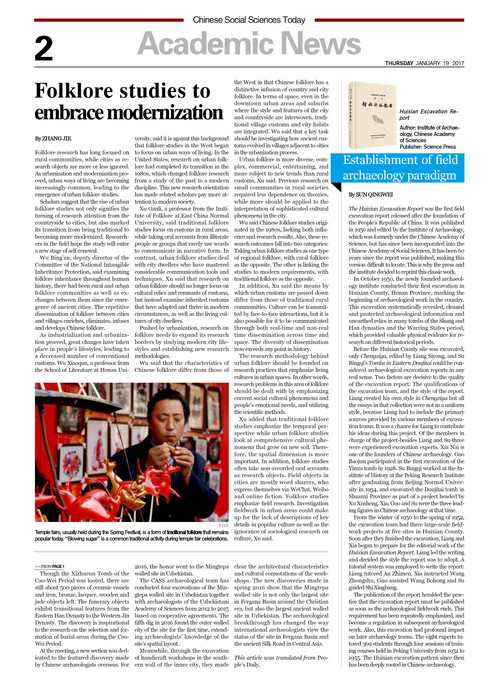Folklore studies to embrace modernization
Temple fairs, usually held during the Spring Festival, is a form of traditonal folklore that remains popular today. “Blowing sugar” is a common traditional activity during temple fair celebrations.
By ZHANG JIE
Folklore research has long focused on rural communities, while cities as research objects are more or less ignored. As urbanization and modernization proceed, urban ways of living are becoming increasingly common, leading to the emergence of urban folklore studies.
Scholars suggest that the rise of urban folklore studies not only signifies the turning of research attention from the countryside to cities, but also marked its transition from being traditional to becoming more modernized. Researchers in the field hope the study will enter a new stage of self-renewal.
Wu Bing’an, deputy director of the Committee of the National Intangible Inheritance Protection, said examining folklore inheritance throughout human history, there had been rural and urban folklore communities as well as exchanges between them since the emergence of ancient cities. The repetitive dissemination of folklore between cities and villages enriches, eliminates, infuses and develops Chinese folklore.
As industrialization and urbanization proceed, great changes have taken place in people’s lifestyles, leading to a decreased number of conventional customs. Wu Xiaoqun, a professor from the School of Literature at Henan University, said it is against this background that folklore studies in the West began to focus on urban ways of living. In the United States, research on urban folklore had completed its transition in the 1980s, which changed folklore research from a study of the past to a modern discipline. This new research orientation has made related scholars pay more attention to modern society.
Xu Ganli, a professor from the Institute of Folklore at East China Normal University, said traditional folklore studies focus on customs in rural areas, while taking oral accounts from illiterate people or groups that rarely use words to communicate in narrative form. In contrast, urban folklore studies deal with city dwellers who have mastered considerable communication tools and techniques. Xu said that research on urban folklore should no longer focus on cultural relics and remnants of customs, but instead examine inherited customs that have adapted and thrive in modern circumstances, as well as the living cultures of city dwellers.
Pushed by urbanization, research on folklore needs to expand its research borders by studying modern city lifestyles and establishing new research methodologies.
Wu said that the characteristics of Chinese folklore differ from those of the West in that Chinese folklore has a distinctive infusion of country and city folklore. In terms of space, even in the downtown urban areas and suburbs where the style and features of the city and countryside are interwoven, traditional village customs and city habits are integrated. Wu said that a key task should be investigating how ancient customs evolved in villages adjacent to cities in the urbanization process.
Urban folklore is more diverse, complex, commercial, entertaining, and more subject to new trends than rural customs, Xu said. Previous research on small communities in rural societies required less dependence on theories, while more should be applied to the interpretation of sophisticated cultural phenomena in the city.
Wu said Chinese folklore studies originated in the 1980s, lacking both influence and research results. Also, these research outcomes fall into two categories: Taking urban folklore studies as one type of regional folklore, with rural folklore as the opposite. The other is linking the studies to modern requirements, with traditional folklore as the opposite.
In addition, Xu said the means by which urban customs are passed down differ from those of traditional rural communities. Culture can be transmitted by face-to-face interactions, but it is also possible for it to be communicated through both real-time and non-real time dissemination across time and space. The diversity of dissemination now exceeds any point in history.
The research methodology behind urban folklore should be founded on research practices that emphasize living cultures in urban spaces. In other words, research problems in this area of folklore should be dealt with by emphasizing current social cultural phenomena and people’s emotional needs, and utilizing the scientific methods.
Xu added that traditional folklore studies emphasize the temporal perspective while urban folklore studies look at comprehensive cultural phenomena that grow on new soil. Therefore, the spatial dimension is more important. In addition, folklore studies often take non-recorded oral accounts as research objects. Field objects in cities are mostly word sharers, who express themselves via WeChat, Weibo and online fiction. Folklore studies emphasize field research. Investigation fieldwork in urban areas could make up for the lack of descriptions of key details in popular culture as well as the ignorance of sociological research on culture, Xu said.



